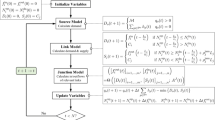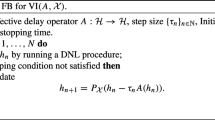Abstract
The ability of simulation-based dynamic traffic assignment (SBDTA) models to produce reliable solutions is crucial for practical applications, particularly for those involving the comparison of modeling results across multiple scenarios. This work reviews, implements and compares novel and existing techniques for finding equilibrium solutions for SBDTA problems, focusing on their convergence pattern and stability of the results. The considered methodologies, ranging from MSA and gradient-based heuristics to column generation frameworks and partial demand loading schemes, have not been previously compared side-to-side in the literature. This research uses a single SBDTA platform to conduct such comparison on three real networks, including one with more than 200,000 trips. Most analyzed approaches were found to require a similar number of simulation runs to reach near-equilibrium solutions. However, results suggest that the quality of the results for a given convergence level may vary across methodologies.








Similar content being viewed by others
References
Bertsekas D, Gafni EM (1983) Projected Newton methods and optimization of multi-commodity flows. IEEE Trans Autom Control 28(12):1000–1006
Boyles S, Duthie J, Melson C, Rambha T (2013) Diverge models and dynamic traffic equilibria. INFORMS Annual Meeting
Chiu YC, Bustillos B (2009) A gap function vehicle-based solution procedure for consistent and robust simulation-based dynamic traffic assignment. Transportation Research Board 88th Annual Meeting. No. 09-3721
Chiu YC, Bottom J, Mahut M, Paz A, Balakrishna R, Travis Waller S (2011) Dynamic traffic assignment: a primer. Transportation Research E-Circular E-C153
Daganzo C (1994) The cell transmission model: a dynamic representation of highway traffic consistent with the hydrodynamic theory. Transp Res B Methodol 28(4):268–287
Daganzo C (1995) The cell transmission model, part II: network traffic. Transp Res B Methodol 29.2:79–93
Florian M, Mahut M, Tremblay N (2008) Application of a simulation-based dynamic traffic assignment model. Eur J Oper Res 198(3):1381–1392
Iryo T (2011) Multiple equilibria in a dynamic traffic network. Transp Res B Methodol 45(6):867–879
Iryo T (2013) Investigating factors for existence of multiple equilibria in dynamic traffic network. Netw Spat Econ. doi:10.1007/s11067-013-9206-6
Jayakrishnan R, Tsai WK, Prashker JN, Rajadhyaksha S (1994) A faster path-based algorithm fortraffic assignment. Transp Res Rec 1443:75–83
Lighthill MJ, Whitham JB (1955) On kinematic waves II: a theory of traffic flow on long crowded roads. Proc R Soc A 229:317–245
Liu HX, He X, He B (2009) Method of successive weighted averages (MSWA) and selfregulated averaging schemes for solving stochastic user equilibrium problem. Netw Spat Econ 9(4):485–503
Lo H, Chen A (2000) Reformulating the general traffic equilibrium problem via a smooth gap function. Math Comput Model 31(2/3):179–195
Lu C-C, Mahmassani HS, Zhou X (2009) Equivalent gap function-based reformulation and solution algorithm for the dynamic user equilibrium problem. Transp Res B Methodol 43(3):345–364
Mahut M, Florian M, Tremblay N (2008) Comparison of assignment methods for simulation-based dynamic-equilibrium traffic assignment. Proceeding of the Transportation Research Board 87th Annual Meeting (DVD), Washington, DC
Mounce R, Carey M (2011) Route swapping in dynamic traffic networks. Transp Res B Methodol 45(1):102–111
Powell W, Sheffi Y (1982) The convergence of equilibrium algorithms with predetermined step sizes. Transp Sci 16:45–55
Richards PI (1956) Shockwaves on the highway. Oper Res 4:42–51
Robbins H, Monro S (1951) A stochastic approximation method. Ann Math Stat 400–407
Sbayti H, Lu C, Mahmassani H (2007) Efficient implementation of method of successive averages in simulation-based dynamic traffic assignment models for large-scale network applications. Transp Res Rec J Transp Res Board 2029:22–30
Sheffi Y (1985) Urban transportation networks: equilibrium analysis with mathematical programming methods. Prentice-Hall, Inc, p 399
Smith MJ (1979) The existence, uniqueness and stability of traffic equilibria. Transp Res B Methodol 13(4):295–304
Szeto W, Lo H (2006) Dynamic traffic assignment: properties and extensions. Transportmetrica 2:31–52
Tong C, Wong S (2010) Heuristic algorithms for simulation-based dynamic traffic assignment. Transportmetrica 6(2):97–120
Torbjörn L, Patriksson M (1992) Simplicial decomposition with disaggregated representation for the traffic assignment problem. Transportation Science 26(1):4–17
Yang I, Jayakrishnan R (2012) Gradient projection method for simulation-based dynamic traffic assignment. Transp Res Rec J Transp Res Board 2284(1):70–80
Yperman I (2007) The link transmission model for dynamic network loading. https://lirias.kuleuven.be/handle/1979/946
Ziliaskopoulos AK, Travis Waller S (2000) An internet-based geographic information system that integrates data, models and users for transportation applications. Transportation Research Part C: Emerging Technologies 1:427–444
Author information
Authors and Affiliations
Corresponding author
Rights and permissions
About this article
Cite this article
Levin, M.W., Pool, M., Owens, T. et al. Improving the Convergence of Simulation-based Dynamic Traffic Assignment Methodologies. Netw Spat Econ 15, 655–676 (2015). https://doi.org/10.1007/s11067-014-9242-x
Published:
Issue Date:
DOI: https://doi.org/10.1007/s11067-014-9242-x




